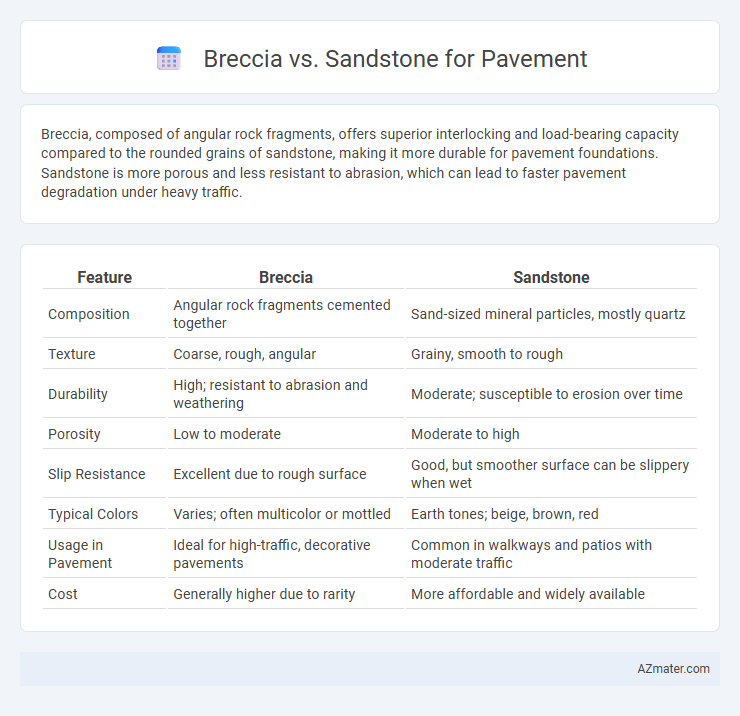Breccia, composed of angular rock fragments, offers superior interlocking and load-bearing capacity compared to the rounded grains of sandstone, making it more durable for pavement foundations. Sandstone is more porous and less resistant to abrasion, which can lead to faster pavement degradation under heavy traffic.
Table of Comparison
| Feature | Breccia | Sandstone |
|---|---|---|
| Composition | Angular rock fragments cemented together | Sand-sized mineral particles, mostly quartz |
| Texture | Coarse, rough, angular | Grainy, smooth to rough |
| Durability | High; resistant to abrasion and weathering | Moderate; susceptible to erosion over time |
| Porosity | Low to moderate | Moderate to high |
| Slip Resistance | Excellent due to rough surface | Good, but smoother surface can be slippery when wet |
| Typical Colors | Varies; often multicolor or mottled | Earth tones; beige, brown, red |
| Usage in Pavement | Ideal for high-traffic, decorative pavements | Common in walkways and patios with moderate traffic |
| Cost | Generally higher due to rarity | More affordable and widely available |
Introduction to Pavement Material Choices
Breccia and sandstone are common pavement materials with distinct properties influencing their suitability for different applications. Breccia, composed of angular rock fragments, offers high durability and load-bearing capacity, making it ideal for high-traffic or industrial pavement areas. Sandstone, characterized by its granular texture and moderate hardness, provides aesthetic appeal and better slip resistance for pedestrian-friendly pavements.
What is Breccia? Key Characteristics
Breccia is a coarse-grained sedimentary rock composed of angular, broken fragments cemented together by a finer matrix, often limestone or silica. Key characteristics include its jagged clasts, wide grain size variation, and high compressive strength, making it durable but less smooth compared to sandstone. These properties contribute to breccia's suitability for rugged pavement applications where strength and wear resistance are critical.
What is Sandstone? Key Characteristics
Sandstone is a sedimentary rock composed primarily of sand-sized mineral particles or rock fragments, predominantly quartz and feldspar, which provide durability and resistance to weathering. Its porous nature allows for good drainage, making it suitable for pavement applications in various climates. The natural variation in color and texture of sandstone adds aesthetic appeal while maintaining functional strength and slip resistance for pedestrian and vehicular surfaces.
Formation Processes of Breccia and Sandstone
Breccia forms through the rapid cementation of angular rock fragments typically deposited near fault zones or volcanic eruptions, creating a highly durable and coarse texture ideal for pavements requiring strong resistance to mechanical stress. Sandstone develops from the gradual accumulation, compaction, and cementation of sand-sized mineral particles, primarily quartz, resulting in a more uniform and porous material suitable for pavements needing good drainage and moderate load-bearing capacity. The contrasting formation processes of breccia and sandstone lead to distinct structural properties that influence their performance and suitability in various pavement applications.
Aesthetic Appeal: Breccia vs Sandstone
Breccia offers a dramatic aesthetic appeal with its angular, multicolored fragments creating a bold and rugged texture, making it ideal for statement pavements. Sandstone provides a softer, earthy tone and smooth, uniform surface that enhances natural landscapes and historic settings with a subtle yet elegant look. Choosing between breccia and sandstone for pavement depends on the desired visual impact and the architectural context.
Durability and Strength Comparison
Breccia exhibits higher durability and compressive strength compared to sandstone, making it more suitable for high-traffic pavement applications. The angular fragments in breccia create a tightly interlocked structure that resists wear and heavy loads effectively. Sandstone, while aesthetically pleasing, tends to be softer and more porous, resulting in lower resistance to abrasion and reduced longevity under constant traffic stress.
Slip Resistance and Safety Factors
Breccia offers superior slip resistance for pavement applications due to its angular, coarse-grained texture, which provides enhanced traction compared to the smoother, rounded grains of sandstone. The increased roughness of breccia surfaces reduces skid risks, contributing to improved pedestrian and vehicular safety in wet or icy conditions. Safety factors also favor breccia in high-traffic areas where slip hazards are critical, making it a preferred choice for durable, non-slip pavement surfaces.
Maintenance Requirements for Both Stones
Breccia pavements require regular sealing and prompt repair of cracks to prevent water infiltration and deterioration, while sandstone surfaces demand frequent cleaning to mitigate erosion from sand particles and environmental pollutants. Breccia's angular fragments can lead to faster wear if not maintained properly, whereas sandstone's softer composition often necessitates periodic resurfacing to maintain structural integrity. Both materials benefit from routine inspections to address weathering and surface damage, ensuring longevity and safety in pavement applications.
Cost Analysis: Breccia vs Sandstone Pavements
Breccia pavements typically incur higher initial costs due to the material's angular fragments and complex quarrying process compared to sandstone, which is more abundant and easier to extract. Maintenance expenses for breccia can be lower because of its high durability and resistance to weathering, whereas sandstone may require more frequent repairs due to its softer composition. Overall, choosing between breccia and sandstone pavements involves balancing upfront investment with long-term durability and maintenance costs.
Best Applications and Recommendations
Breccia, characterized by angular, coarse fragments, excels in heavy-duty pavement applications requiring high load-bearing capacity and durability, such as industrial zones and highways, due to its superior strength and resistance to abrasion. Sandstone, with its finer grains and natural aesthetic, is recommended for pedestrian pathways, parks, and decorative pavements where slip resistance and visual appeal are priorities over heavy load-bearing. Selecting breccia or sandstone depends on traffic intensity and design requirements, with breccia favored for structural performance and sandstone for surface texture and appearance.

Infographic: Breccia vs Sandstone for Pavement
 azmater.com
azmater.com